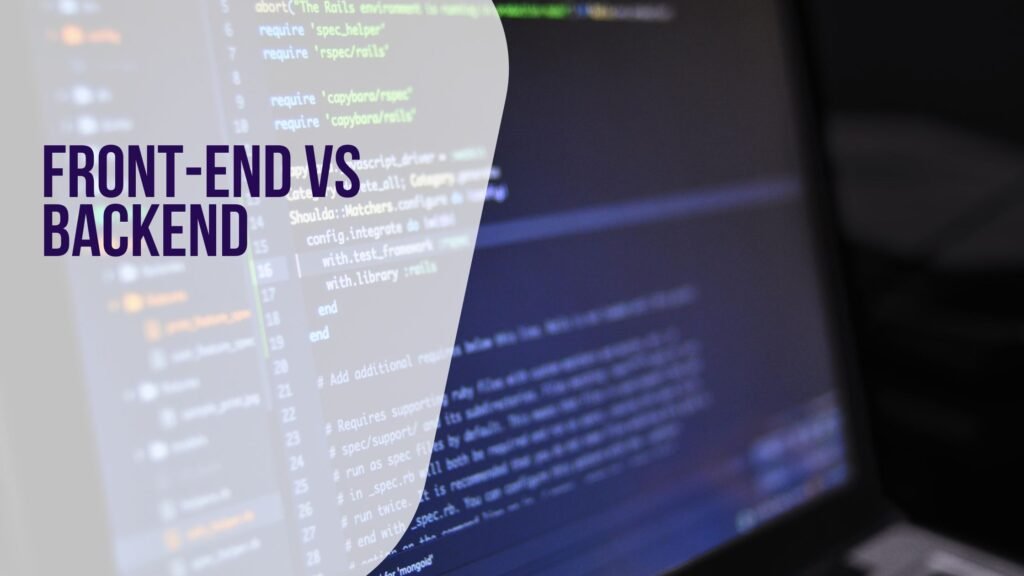
Frontend and Backend in Web Development: A Comprehensive Overview
Frontend and Backend are integral components of web development, each playing a crucial role in shaping the user experience and functionality of a website. In this comprehensive guide, we’ll delve into the intricacies of frontend and backend development, exploring the languages, frameworks, and technologies that power these essential aspects of the web.
Understanding Frontend Development:
What is Frontend?
Frontend, also known as the client-side, is the visible part of a website that users directly interact with. It encompasses the graphical user interface (GUI), including design elements such as text, images, videos, buttons, and navigation menus.
Languages of Frontend: Three fundamental languages drive frontend development:
HTML (Hypertext Markup Language): HTML is the backbone of frontend development, providing the structure and markup for web pages. It defines the elements on a page, such as headings, paragraphs, images, and links.
CSS (Cascading Style Sheets): CSS focuses on the presentation of HTML elements. It controls the layout, styling, and visual aspects of a webpage, ensuring a consistent and aesthetically pleasing user interface.
JavaScript: JavaScript adds interactivity and dynamic behavior to websites. It enables features like form validation, image sliders, and real-time updates, making the user experience more engaging.
Frontend Frameworks and Libraries:
AngularJS: AngularJS is an open-source frontend framework for building single-page web applications (SPAs). It extends HTML with directives, enhancing the dynamic capabilities of web applications.
React.js: Developed and maintained by Facebook, React.js is a declarative and efficient JavaScript library for building user interfaces. It simplifies the development of interactive and responsive frontends.
Bootstrap: Bootstrap is a popular HTML, CSS, and JavaScript framework for creating responsive and mobile-first websites. It provides a set of pre-designed components that expedite frontend development.
jQuery: jQuery is a widely-used JavaScript library that simplifies DOM manipulation, event handling, and animation. It streamlines frontend development tasks, making them more accessible.
SASS: SASS (Syntactically Awesome Stylesheets) is a CSS extension language that introduces features like variables, nesting, and inheritance. It enhances the maintainability and structure of stylesheets.
Flutter: Flutter, an open-source UI development SDK by Google, facilitates the creation of natively compiled applications for mobile, web, and desktop using a single code base.
Diving into Backend Development:
What is Backend?
The backend, or server-side, is the behind-the-scenes part of a website that users don’t directly interact with. It manages data storage, processing, and ensures the functionality of the frontend.
Languages of Backend:
PHP: PHP is a server-side scripting language designed for web development. It executes on the server, generating dynamic content and interacting with databases.
C++: C++ serves as a general-purpose programming language and is increasingly used for backend development due to its efficiency and versatility.
Java: Java, a widely-used programming language, is highly scalable and employed extensively for backend development. It offers robust support for building enterprise-level applications.
Python: Python’s simplicity and efficiency make it a popular choice for backend development. It facilitates rapid development and integration with other systems.
Node.js: Node.js allows executing JavaScript code on the server side, enabling the development of scalable and high-performance backend services.
Backend Frameworks:
Express: Express is a minimalist Node.js framework that simplifies backend development. It is well-suited for building single-page, multi-page, and hybrid web applications.
Django: Django, a Python-based framework, follows the model-template-views pattern. It excels in building large and complex web applications, offering speed, security, and scalability.
Ruby on Rails: Ruby on Rails, operating on the model-view-controller architecture, provides default structures for web services, web pages, and databases, fostering rapid development.
Laravel: Laravel, a PHP framework, emphasizes elegant syntax and code simplicity. It allows developers to reuse components, enhancing the efficiency of web application development.
Spring: Spring, a Java-based framework, offers infrastructure support for Java applications. It extends support to various frameworks like Hibernate, Struts, and EJB, facilitating rapid development.
Integrating Frontend and Backend:
The synergy between frontend and backend is vital for creating a cohesive and functional website. Here’s how these components work together:
User Interaction: The frontend facilitates user interaction through the GUI, collecting user inputs and displaying information. This data is then sent to the backend for processing.
Data Processing: The backend processes user inputs, interacts with databases, and performs the necessary computations. It ensures data integrity and security.
Communication: Communication between frontend and backend is often achieved through APIs (Application Programming Interfaces). APIs allow seamless data exchange between the two components.
Rendering: Once the backend processes the data, the frontend dynamically updates to reflect the changes. This dynamic rendering enhances the user experience.
Conclusion:
In conclusion, frontend and backend development are integral parts of web development, each contributing to the overall functionality and user experience of a website. The diverse languages, frameworks, and technologies associated with frontend and backend empower developers to create robust and engaging web applications. The synergy between these components ensures a seamless and interactive online experience for users. Whether you’re a frontend enthusiast crafting visually appealing interfaces or a backend maestro orchestrating data and processes, understanding both sides is essential for becoming a proficient web developer.
